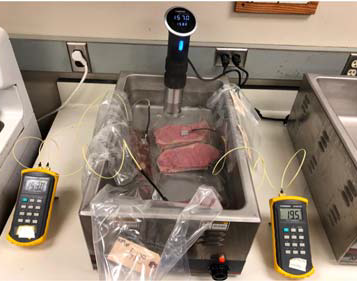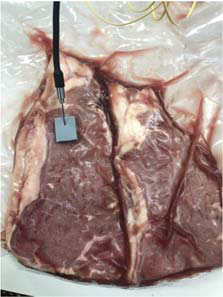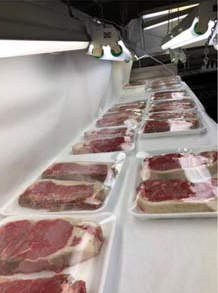PROJECT SUMMARY
Predicting Beef Flavor Differing in Lipid Heat Denaturation and Maillard Reaction Products
- Principle Investigator(s):
- Rhonda K. Miller1, Anderson R. Cabral1, Chris R. Kerth1 and Dale R. Woerner2
- Institution(s):
- 1Texas A&M University, Department of Animal Science
- 2Texas Tech University, Department of Animal Science
- Completion Date:
- June 2019
Background
Several studies have shown that multiple factors impact flavor in beef (Calkins & Hodgen, 2007; Farmer & Patterson, 1991; Kerth & Miller, 2015; Legako, Dinh, Miller, & Brooks, 2015). Through the development of the standardized beef whole muscle flavor lexicon, a comprehensive list of flavors were determined present in beef whole muscle cuts (Adhikari et al., 2011). In addition, effects of cooking method, degree of doneness, and cut on beef flavor attributes and consumer liking have been studied. Furthermore, research on consumer perceptions of millennials, non‐millennials, heavy beef‐eaters, and light beef‐eaters has been conducted. The impact of grind size, patty thickness, fat level, holding time and cooking method effects on beef flavor attributes and consumer liking in ground beef also has been studied. Consumer studies have included Central Location Tests and In‐Home Use Tests to assess consumer liking (Bamsey, 2017; Beavers, 2017; Berto, 2015; Glasscock, 2014; Laird, 2015; Luckemeyer, 2015). Most recently, these previous studies have been used to model beef flavor. Flavor has been shown to be influenced by the development of volatile aromatic compounds that are derived from either lipid heat denaturation, Maillard reaction products, or their interaction.
This study was designed to understand how initial differences in raw beef lipid oxidation (defined using TBARS values) affects the development of beef flavor attributes and volatile aroma compounds using three cooking methods. The study was conducted using Low Choice top loin steaks subjected to three cooking methods (sous‐vide, sous‐vide with sear, and flat top grill) and three raw lipid oxidation levels (0.1, 0.5 and >1.0 mg malonaldehyde/kg sample induced by storage environment). These treatments are designed to create differences in raw meat lipid oxidation. It is well established that if raw meat has higher levels of lipid oxidation, heat‐denatured oxidation occurs at a higher rate during cooking and products of lipid oxidation, defined as off‐flavors, are stronger and the steak is rated less desirable by consumers.
Three cooking methods were used to induce differences in lipid heat degradation and Maillard reactions. These cooking methods are sous‐vide, sous‐vide with searing, and grilling. These are common cooking methods used in the foodservice industry for top loin steaks. Sous‐vide cooking was selected as a low‐temperature cooking method. In this method, steaks are vacuum‐packaged in cook‐in film and cooked in water. The sous‐vide with searing treatment is commonly used in foodservice. Steaks are reheated in the original package. When the steak has reached final temperature, it is removed from the bag and seared to give the steak grill marks for desirable visual appearance and to induce the Maillard reaction or grill flavor. This treatment should induce lipid heat degradation during sous‐vide cooking and Maillard reaction products during grilling. The third cooking treatment is to grill steaks on a flat top grill to induce the highest levels of Maillard reaction products.
Steaks were evaluated using an expert, trained beef flavor and texture descriptive attribute panel, for volatile aroma chemical compounds using a gas chromatography–mass spectrometry (GC/MS) system, and Warner‐Bratzler shear force. The results were used to validate the flavor model currently being developed at Texas A&M University using past data. The REIMS technology identified by Colorado State University was used to assess volatiles at the end of cooking to determine the efficacy of the instantaneous GC/MS technology to predict beef flavor.
The objectives of this study were to 1) validate the beef flavor model developed in 2017/2018; 2) utilize REIMS to predict beef flavor; and 3) more fully understand how level of lipid oxidation in raw meat in combination with cooking method impacts beef flavor.
Methodology
Low Choice beef strip loins subprimals were purchased. Full loins were treated by dipping in 3% lactic acid solution for one minute for microbiological spoilage control. Each subprimal was fabricated into twelve, 2.54 cm top loin steaks using a bandsaw and randomly assigned to treatments for trained panel, lipid oxidation (TBARS), Warner‐Bratzler shear force (WBSF).
Steaks were stored to induce differences in lipid oxidation of: Low ‐ approximately 0.1 mg of malonaldehyde/kg of sample; Medium ‐ approximately 0.5 mg of malonaldehyde/kg of sample; and High > 1.0 mg of malonaldehyde/kg of sample. To create the three levels of lipid oxidation, low group was vacuum‐packed at the processing facility and cooked on sous‐vide on the same day. Medium and high group steaks were placed in Styrofoam trays with PVC overwrap and placed under fluorescence lights at 4°C for two days for medium group and five days for the high group to induce lipid oxidation in the raw steak without microbiological spoilage. Steaks were evaluated for raw objective color, before and after the storage time (L*, a*, and b* color values).
The steaks where cooked using a sous‐vide, sous‐vide plus grill, or grill. For sous‐vide, steaks were vacuum‐ packaged in cook‐in bags prior to the cooking procedure. Water was set to 49°C temperature. The steaks were cooked until they reached an internal temperature of 49°C. After cooked, they were placed in a cooler at 4°C overnight. The following day, the steaks were placed back in the sous‐vide at 70°C for reheat until reached the final internal temperature of 70°C. Steaks assigned to sous‐vide with searing (Sous‐vide + grill) treatment were cooked and chilled in the manner as described above for sous‐vide only. The following day, the steaks were reheated until they reached the internal temperature of 70°C in the sous‐vide. After the steaks reached the internal temperature of 70°C in the sous‐ vide, the steaks were placed on a dry heat cooking flat solid stainless‐steel surface at 204°C for one minute and then they were flipped over for one more minute for creating the browning color on the outside. Steaks assigned to the flat top grilling method were cooked using a dry heat cooking flat solid stainless‐steel surface at 204°C to an internal temperature endpoint of 70°C and were turned at 35°C.
The steaks were evaluated by an expert trained meat descriptive attribute using a 16‐point scale within each lexicon (0 = none and 15 = extremely intense).
The data were analyzed using PROC GLM procedures of SAS to examine the effects of raw TBARS group and cooking method on descriptive flavor and texture sensory attributes, TBARS values (raw and cooked), and volatile aroma compounds from both GC/MS systems. The Beef Modeling Equation was used to predict trained descriptive sensory attributes using the volatile aromatic compounds from the GC/MS system. Additionally, the results of the equation were used to test the validity of the Beef Modeling Equation.
Findings
The SV, SVG, and grill cooking methods were responsible to create a wide range of flavor attributes and volatile compounds. The grill treatment was responsible for developing more products from the Maillard reaction and these products were responsible in producing more positive flavor attributes from the trained panelists, produce more pyrazines, and more Strecker aldehydes. The grill treatment was also able to mask some off‐flavors, and more tender samples. All three cooking methods affected tenderness, which all the treatments had “very tender” and “tender” steaks. The low, medium, and high levels of lipid oxidation were responsible for creating a wide range of flavor attributes and volatile compounds. The high level of oxidation was responsible for creating more negative flavor attributes, categorized as off‐flavors, developing more aldehydes and alcohols due to the oxidation. The storage time negatively affected redness and luminosity of the steaks. The REIMS technology was able to predict with high accuracy both level of lipid oxidation and cooking methods.
Packaging method greatly impacts the types of flavors and tenderness produced by beef products. In this study, packaging had a greater impact on tenderness and flavor as measured, when compared to muscle. Proper selection of packages by processors can result in longer shelf life with a more tender, flavorful product.
Implications
Beef flavor is one of the biggest factors for the consumer repeat purchase. However, beef flavor is very complex and there are a lot of factors that affect how beef flavor is developed and perceived. This research was able to describe how initial level of lipid oxidation developed from a retail set up and Maillard reaction products produce beef flavor. Results can be used by foodservice operators and the industry as a whole to understand better cooking methods and lipid oxidation and how that impacts beef flavor.

Figure 1. Strip loin steaks in sous‐vide cooking method.

(a)

(b)
Figure 2. Thermocouple inserted through the foam tape and the vacuumed bag (a), steaks overwrapped and displayed under lights (b).
(a)
(b)
Figure 3. Raw strip loin steaks stored for 5 days – high lipid oxidation level (a), cooked strip loin steaks at the grill cooking method (b), at the sous‐vide cooking method (c), at the sous‐vide plus grill cooking method (d).
References
- Adhikari, K., Chambers IV, E., Miller, R. K., Vazquez, L. A., Bhumiratana, N., & Philips, C. (2011). Development of a lexicon for beef flavor in intact muscle. Journal of Sensory Studies, 26, ‐420.
- Bamsey, M. L. (2017). Beef flavor myology. Master's Thesis, Texas A&M University, College Station.
- Beavers, B. A. (2017). Relationship between descriptive flavor and texture attributes and consumer acceptance in ground beef patties. Master's Thesis, Texas A&M University, College Station.
- Berto, M. C. (2015). Consumer attitudes of predicted flavor aromas in steaks created with different steak thickness, quality grades, and cooking surface temperatures. Master's Thesis, Texas A&M University, College Station.
- Calkins, C. R., & Hodgen, J. M. (2007). A fresh look at meat flavor. Meat Science, 77(1), 63‐80. Farmer, L. J., Patterson, R. L. S. (1991). Compounds contributing to meat flavour. Food Chemistry, 40(2), 201–205. Glasscock, R. A. (2014). Beef Flavor Attributes and Consumer Perception. Master's Thesis, Texas A&M University, College Station.
- Kerth, C. R., & Miller, R. K. (2015). Beef flavor: a review from chemistry to consumer. Journal of the Science of Food and Agriculture, 95(14), 2783‐2798.
- Laird, H. L. (2015). Millennial’s Perception of Beef Flavor. Master's Thesis, Texas A&M University, College Station.
- Legako, J. F., Dinh, T. T. N., Miller, M. F., & Brooks, J. C. (2015). Effects of USDA beef quality grade and cooking on fatty acid composition of neutral and polar lipid fractions. Meat science, 100, 246‐255.
- Luckemeyer, T. J. (2015). Beef flavor attributes and consumer perception of light beef eaters. Master's Thesis, Texas A&M University, College Station.